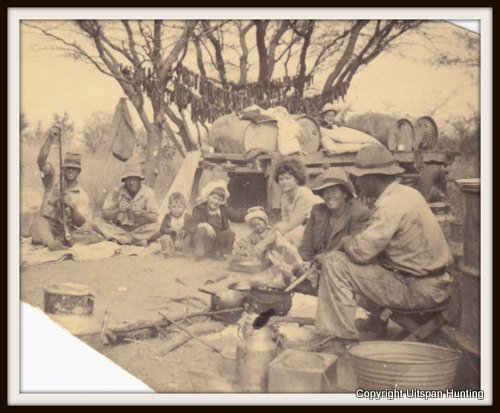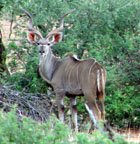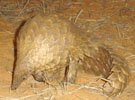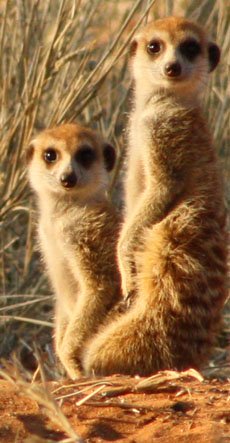For more information about our hunting safaris, don’t hesitate to reach out and contact us!
The Common Pangolin of Africa
We were recently very lucky to find a Common Pangolin (Manis temminckii) on Uitspan Ranch in Namibia, near the Botswana border.
As we have grown up in the Kalahari, we know that these animals are rare and very difficult to spot.
Since they resemble something from an ancient world, these mammals intrigue people. We therefore grabbed the opportunity to make a little video of it.
Comments from YouTube-viewers
Here are some of the comments the video received on YouTube:
"Thanks so much for this! I've loved these guys ever since I saw one in a book when I was a kid. Never have seen one moving before though, only pictures. This is a great video."
"Excellent! What a quirky little beastie."
"I thought these guys were nocturnal, but here he is running around (and curling up) during the day. Horray for pangolins!"
"hahhah! I love how it hides its head at the last part."
"The coolest animal ever, man."
They've said it all!
Have a look at this special animal living also in the Kalahari and then read some interesting facts about it.
General information
According to the African Wildlife Foundation, three types of pangolins can be found in Africa, namely the giant pangolin (Manis gigantea), the tree pangolin (Manis tricuspis) and the ground or common pangolin (Manis temminckii).
Only the common pangolin live in the southern part of Africa and this is the one we were lucky to find roaming around at sunset. It prefers sandy soils and is most often found in savannas within reach of water.
Physical characteristics
This pangolin specie can grow to a length of about 42 inches and weigh 30 to 40 pounds.
Pangolins have poor sight and do not have any external ears, although their hearing is very good. Their sense of scent is well developed and they locate ants' nests by smell.To protect its eyes from swarming insects, it has a hard covering that slips into place over the eyes.
Diet
The common pangolin typically feeds on termites and ants. It has powerful claws for this task and will tear open termite mounds and anthills. It is well adapted to this, with a very long (up to 16 inches) sticky tongue, which is stored inside a pocket in the mouth until needed.
The pangolin has no teeth, but it does have a very rugged stomach that is similar to a gizzard. While digging, the pangolin will consume small stones that will rest in its stomach and aids in grinding up the food.
Behavior
Pangolins are mainly nocturnal. All pangolins are able to roll themselves into a ball to defend them. They are also protected by the cutting action of their armor-plated scales, worked by powerful muscles. It can inflict serious wounds on anything inserted between them.
Pangolins also have anal scent glands that emit strong, foul smelling secretions.
Pangolins are normally solitary.
Infant pangolins ride crossways (or lengthways when they are older) at the base of their mother's tail. If the mother senses danger the baby slips under her and is protected when she rolls up her body.
Interesting facts
- Large predators such as the leopard and hyena can kill the pangolin.
- They have a life span of 20 years (according to several resources).
- Their long thick tail gets in the way of mating in the usual mammal position. The male mounts therefore from the side with his tail wrapped round the female's.
We tried to pick up the one on the video, but it made quick, short muscular movements with its body.
It is definitely a very good way of
protecting itself, since these movements caused the scales to cut our
hands quite nasty!
~ Webmaster
You are welcome to read more about other Kalahari animals on our website.
Ever thought to build your own online business based upon what you know (from work experience, hobbies, passions, or past-times)? If you know your subject matter, and if you're motivated to build a real business with growing, diversified revenues...click here to read about my experience while creating this website. If I could build this website, YOU can build one too!
Meaning of "Uitspan"
'Uitspan' is an Afrikaans word that means place of rest.
When the Boer settlers moved inland in Southern Africa in the 1800's, they used ox carts. When they found a spot with game, water and green grass, they arranged their ox carts into a circular laager for protection against wild animals and stopped for a rest.
They referred to such an action of relaxation for man and beast, as Uitspan.

(Picture above of our ancestors.)
Did you know? Greater Southern Kudus are famous for their ability to jump high fences. A 2 m (6.56 ft) fence is easily jumped while a 3 m (9.84 ft) high fence is jumped spontaneously. These strong jumpers are known to jump up to 3.5 m (11.48 ft) under stress. |
Did you know? Some animals have one sense more than man!The flehmen response is a particular type of curling of the upper lip in ungulates, felids and many other mammals. This action facilitates the transfer of pheromones and other scents into the vomeronasal organ, also called the Jacobson's Organ. Some animals have one sense more than man!The flehmen response is a particular type of curling of the upper lip in ungulates, felids and many other mammals. This action facilitates the transfer of pheromones and other scents into the vomeronasal organ, also called the Jacobson's Organ.This behavior allows animals to detect scents (for example from urine) of other members of their species or clues to the presence of prey. Flehming allows the animals to determine several factors, including the presence or absence of estrus, the physiological state of the animal, and how long ago the animal passed by. This particular response is recognizable in males when smelling the urine of a females in heat. |


